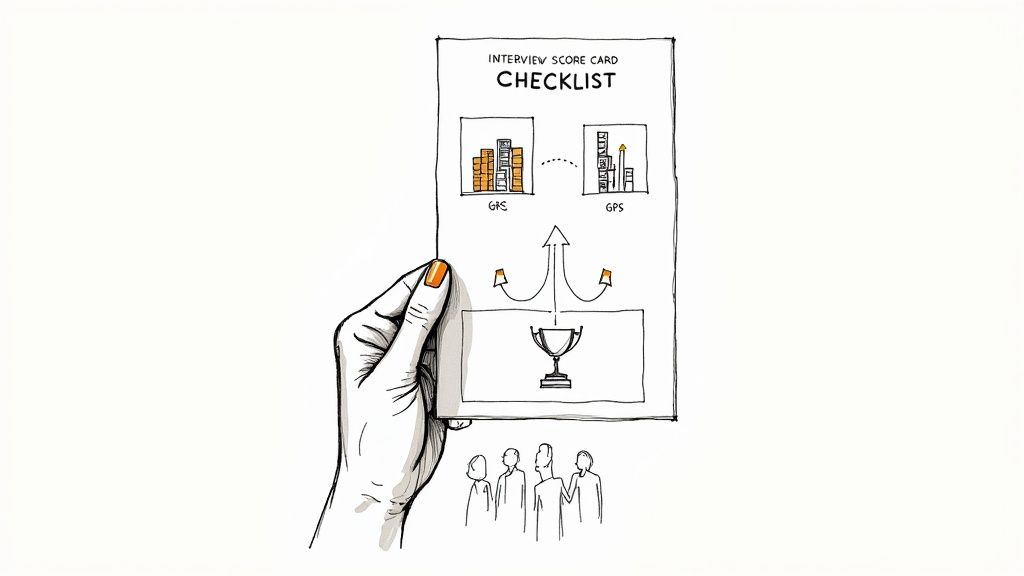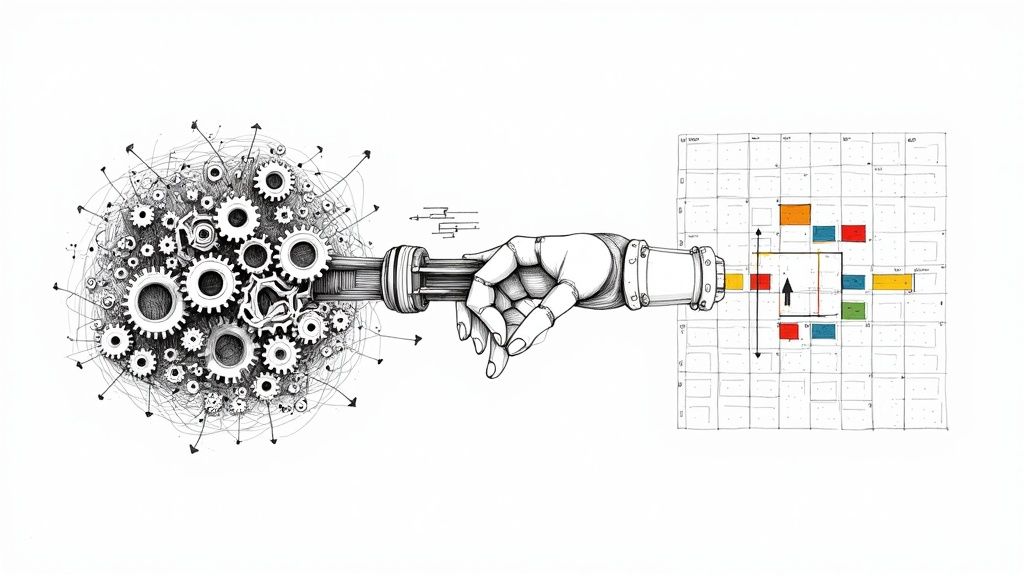Recruitment automation software is your secret weapon against the soul-crushing grind of manual hiring. It’s the difference between your best people building your business and your best people being buried in spreadsheets, endless email chains, and scheduling nightmares.
Think of it as an operational upgrade that stops the bleeding of time, money, and sanity.
The High Cost of Manual Hiring
Let's be honest. Manual recruiting is a special kind of hell. You didn't start a company to become a full-time administrative assistant, yet here you are, chasing down candidates who ghost you after 12 emails and trying to coordinate schedules across five different time zones.
Hope you enjoy spending your afternoons fact-checking resumes, because that’s now your job.
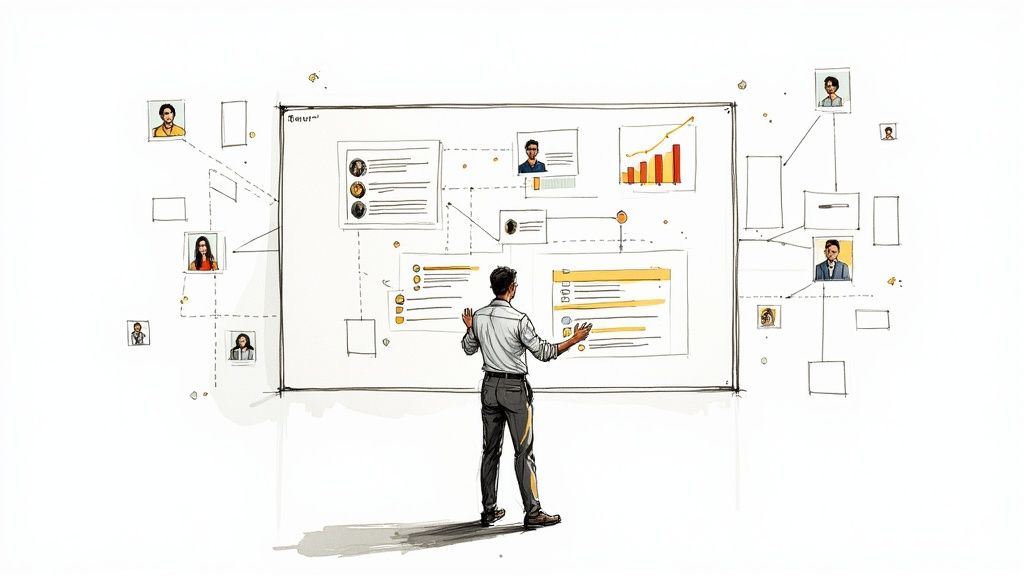
The real kicker isn't just the wasted time; it's the opportunity cost. Every hour your top engineer spends screening unqualified candidates is an hour they’re not shipping product. Every moment your sales director is playing calendar Tetris is a moment they’re not closing deals.
More Than Just Annoying—It’s a Competitive Disadvantage
This administrative muck isn't just frustrating—it’s a genuine threat to your growth. While you’re sifting through a mountain of resumes, your competition is already talking to the top 5% of talent because their system identified them instantly.
Sticking with the old way gives you:
- A Snail's Pace: Your hiring cycle drags on for weeks, maybe months. Top talent doesn't wait around; they accept offers from companies that move decisively.
- The Black Hole Experience: Good candidates get lost in cluttered inboxes and forgotten spreadsheets. This damages your employer brand and ensures they’ll never apply again.
- Burnout Central: Your best people get pulled into the hiring vortex, draining their energy and distracting them from their actual roles.
It’s a broken system that scales terribly. The more you grow, the more the cracks show, until the entire process collapses under its own weight.
The brutal truth is that a slow, manual hiring process tells A-players everything they need to know about your company's efficiency—or lack thereof. It’s a silent killer of great talent pipelines.
That's why tools powered by AI and predictive analytics are no longer a "nice-to-have." They can slash the time-to-fill open positions by up to 30-40% compared to traditional manual processes. By automating the grunt work, you not only speed things up but also improve the quality of your hires. You can explore the data on how automation impacts hiring cycles at Coherent Market Insights.
This isn't just about patching a few leaks. It's about building a modern hiring machine that actually supports your ambition.
What Recruitment Automation Software Actually Does
Let’s cut through the noise and the jargon-filled sales pitches promising a robot utopia. At its heart, recruitment automation software is a set of tools built to take over the most repetitive, mind-numbing parts of hiring. This frees up your team to focus on the human connections that actually land great candidates.
It’s not about replacing your recruiters; it’s about giving them superpowers.
Think of it like a master chef’s kitchen. You’d never ask your star chef to spend their day peeling potatoes and washing dishes, would you? Of course not. You give them specialized tools—food processors, mixers, blast chillers—to handle the grunt work. That way, they can focus on what they do best: creating a Michelin-star meal.
That’s exactly what this software does for your talent pipeline. It’s an assembly line for finding great people.
The Grunt Work That Gets Automated
So, what tasks are we really talking about offloading to the machines? It usually comes down to the high-volume, low-judgment work that can eat up 80% of a recruiter’s time but delivers only a fraction of the value.
- Sourcing and Screening: Instead of a human manually sifting through 300 resumes, the software scans them in seconds. It filters for key skills, years of experience, and specific qualifications. It’s like a talent metal detector, finding the signal in all the noise.
- Candidate Communication: The software can handle the initial outreach, send polite rejection emails (a big one for candidate experience!), and provide automatic status updates. No more great candidates falling into the “black hole” of your team's inbox.
- Interview Scheduling: This is often the biggest time-saver. The software syncs with everyone’s calendars and lets candidates book their own slots. This alone ends the nightmarish back-and-forth of calendar Tetris.
This infographic breaks down just how much of an impact automating these core functions can have.
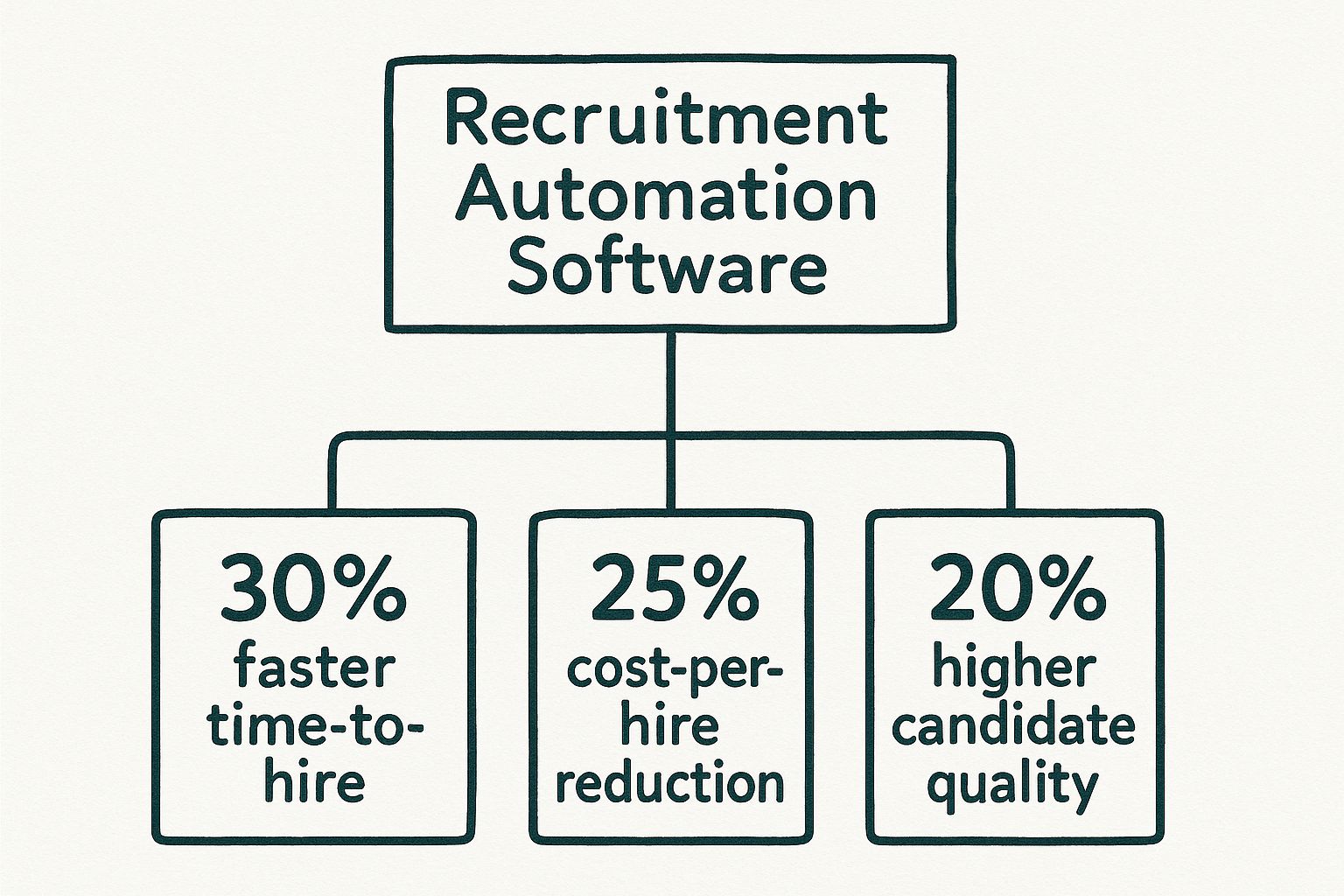
As you can see, the results aren't just about moving faster. They lead to real, tangible improvements in cost, speed, and—most importantly—the quality of the people you end up hiring.
Human vs. Machine: What Actually Gets Automated
To make it crystal clear, let's break down which tasks are perfect for automation and where your human recruiters still shine. Automation handles the mechanics, but the strategy and the human touch are irreplaceable.
| Recruitment Task | Best for Automation (The 'Machine' Work) | Best for Humans (The 'People' Work) |
|---|---|---|
| Initial Screening | Scanning thousands of resumes for keywords, skills, and basic qualifications. | Assessing nuance, potential, and career progression in a top candidate's resume. |
| Scheduling | Syncing multiple calendars and allowing candidates to self-book interview slots. | Personally reaching out to a high-value candidate to find a time that works for them. |
| Communication | Sending bulk status updates, rejection notices, and interview confirmations. | Building rapport, answering complex questions, and checking in with warm leads. |
| Assessments | Administering and scoring standardized skills tests or coding challenges. | Evaluating a candidate's problem-solving approach and creative thinking during an interview. |
| Final Decision | Providing data and analytics on the candidate pool to inform the decision. | Making the final judgment call based on culture fit, team dynamics, and intuition. |
This split is the key. You’re not outsourcing your hiring process; you're just getting rid of the administrative headaches that get in the way of it.
Where Humans Still Reign Supreme
Now for the most important part: what doesn't get automated? The tasks that need nuance, empathy, and strategic thinking. Automation handles the logistics, but your team is still firmly in the driver's seat. To really get a handle on this, it's worth understanding how AI and automation in tech recruitment are shaping the future of hiring.
The goal of recruitment automation software isn't to create a hands-off hiring process. It's to create a hands-on process focused only on the most valuable interactions.
This frees up your team to spend their time on what truly matters:
- Building Relationships: Actually talking to top candidates, listening to their career goals, and understanding what drives them.
- Assessing Culture Fit: Getting a gut feeling for whether someone’s personality and work style will truly click with your team. This is an art, not a science.
- Closing the Deal: Persuading your top choice that your company is the absolute best place for them to grow their career.
- Strategic Planning: Looking at hiring data to spot trends, predict future needs, and build a stronger, more proactive talent pipeline.
This is the central idea. You’re not buying a robot recruiter; you’re buying a system that clears away all the clutter so your human recruiters can finally do the job they were actually hired to do.
The Non-Negotiable Software Features You Need
Every vendor in the recruitment automation space will try to dazzle you with a feature list longer than a grocery receipt. Honestly, most of it is just fluff—shiny bells and whistles designed to distract from what actually matters. Having spent more time testing these platforms than I care to admit, I can tell you there are only three capabilities that are truly mission-critical.
Nail these three, and you’re set. Get them wrong, and you've just bought yourself a very expensive, very complicated spreadsheet.
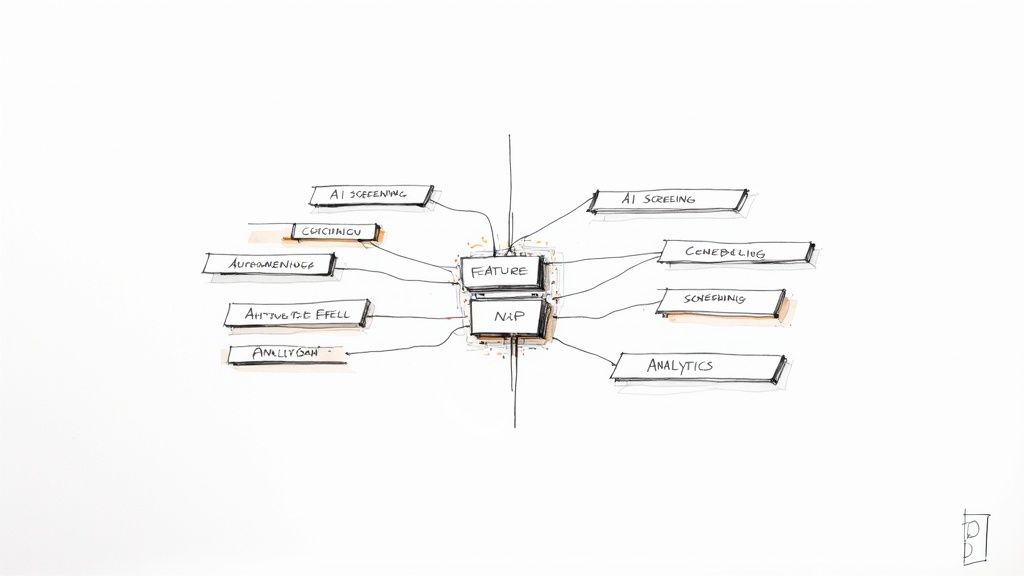
The Talent Metal Detector: AI Sourcing and Screening
This is where the real magic is supposed to happen. Good AI-powered screening acts as your first line of defense against the mountain of unqualified resumes that floods your inbox for every single opening. It's not about matching keywords; any basic ATS can do that.
A smart system gets the context. It understands that a "growth marketer" at a startup is a fundamentally different role than a "digital marketing manager" at a Fortune 500, even if their resumes share a bunch of the same terms. It’s the difference between a sledgehammer and a scalpel.
The best platforms don’t just filter; they learn. They pay attention to the candidates you advance and the ones you reject, getting sharper with every hiring round. This is the feature that stops your senior engineer from wasting a whole Tuesday sifting through 50 bootcamp grads for a principal architect role.
If the AI screening just feels like a fancy keyword search, walk away. It's a gimmick, not a solution.
The "Never Drop a Ball" System: Automated Communication
Let's be real for a second: most companies are absolutely terrible at communicating with candidates. Applications vanish into a black hole, updates never come, and rejection letters—if they arrive at all—are cold and robotic. This doesn't just create a bad candidate experience; it actively damages your brand.
This is exactly why automated communication workflows are a non-negotiable.
A solid platform should let you build simple, trigger-based communication sequences. Think about it:
- Application Received: An instant, branded confirmation email lands in their inbox, letting them know you got it and what to expect next.
- Moved to Next Stage: The system automatically tells the candidate they’ve been shortlisted and gives them a heads-up on what's coming.
- Polite Rejection: A respectful, human-sounding email is sent to candidates who aren't moving forward. This one simple step puts you in the top 10% of employers.
This isn't about spamming candidates with generic, robotic messages. It's about ensuring every single person who shows interest in your company is treated with respect, at scale. A good system makes you look organized and thoughtful, even when you're completely swamped.
And this feature isn't just for the candidate's sake. It rescues your team from the soul-crushing drudgery of copy-and-paste and the mental load of trying to remember who needs an update. It becomes the operational backbone for how you manage candidate relationships.
The Calendar Tetris Solver: Seamless Interview Scheduling
If there is one feature that will deliver an immediate, jaw-dropping return on your investment, it's automated scheduling. That endless email chain of "Does Tuesday at 2 PM work for you?" is a special kind of corporate hell that absolutely murders productivity and kills hiring momentum.
A great scheduling tool has to do more than just send a link to your calendar. It must handle real-world complexity with ease.
Here’s my checklist for a scheduler that doesn't suck:
- Multi-Person Coordination: It has to find and offer times that work for the candidate, the recruiter, and a panel of three different interviewers, all potentially in different time zones. Anything less is basically useless.
- Customizable Buffers: It needs to automatically add buffer time before and after interviews so your team isn't sprinting from one video call to the next with no time to breathe.
- Seamless Rescheduling: Candidates should be able to reschedule on their own with a single click, no email required. This small detail saves an unbelievable amount of back-and-forth.
A clunky, unreliable scheduler is an absolute deal-breaker. It introduces friction at the most critical stage of the hiring process and makes your entire company look amateur. When a top candidate can book a time with your team in 30 seconds, you’ve already made a powerful first impression. It tells them you're a company that has its act together and respects their time.
The Real-World Payoff (Beyond Saving Time)
Sure, everyone talks about how recruitment automation software saves time. Frankly, that’s table stakes. If your fancy new platform isn't freeing up your team from the soul-crushing admin of manual hiring, you’ve been sold a dud. But focusing only on time saved is like buying a supercar and only talking about its cup holders.
The real payoff is far more strategic. It’s about building a better business, not just a faster hiring process. Let’s get beyond the obvious and talk about the ROI that actually shows up on your P&L.
The Quality Multiplier
How many rockstar candidates have you missed because they were buried on page seven of a 300-resume pile? More than you’d like to admit. Manual screening is a game of chance, biased by fatigue and whatever coffee-fueled mood your hiring manager is in that day.
Recruitment automation acts as a quality multiplier. By using AI to screen and score every single applicant against your ideal profile, it surfaces top-tier talent that a human might have overlooked. Suddenly, the hidden gems—the candidates with unconventional backgrounds but the exact skills you need—get the attention they deserve.
This isn’t just about filling roles faster; it's about filling them with better people who drive innovation and stay longer. You stop hiring the best of who you had time to find and start hiring the best, period.
The Brand Protector
Your hiring process is one of the most public-facing parts of your company. A clunky, slow, or ghost-filled candidate experience doesn't just lose you one applicant; it tells dozens of their peers that your company is a disorganized mess.
Think about it:
- The Black Hole: Candidates apply and hear nothing for weeks.
- The Scheduling Nightmare: Endless back-and-forth emails to book a single interview.
- The Ghosting: Candidates are rejected without so much as a courtesy email.
A seamless, automated process protects and enhances your employer brand. When every candidate gets a prompt confirmation, can schedule interviews in seconds, and receives a respectful update on their status, you look professional. Even the people you don't hire walk away with a positive impression, making them more likely to apply again or recommend you to their network.
Your candidate experience is your employer brand in action. Automation ensures that every interaction is professional and respectful, turning your hiring process into a marketing asset instead of a liability.
The Bias Buster
We all have unconscious biases. We gravitate toward people who went to the same schools, worked at similar companies, or just remind us of ourselves. This is human nature, but it's a terrible way to build a high-performing team. It leads to groupthink and stifles the diverse perspectives that are essential for real innovation.
This is where data-driven recruitment automation software becomes a powerful ally. By focusing on objective criteria—skills, experience, and performance on assessments—it helps strip away the noise of unconscious bias. Many platforms can even anonymize resumes, forcing evaluators to focus purely on qualifications. The goal isn't to remove human judgment but to ensure that judgment is applied to a fair and consistently screened pool of candidates.
This shift has a direct impact on your bottom line. More diverse teams are consistently shown to be more innovative, better at problem-solving, and more profitable. The business world is catching on, which is why the market for these tools is booming. Valued at USD 1.14 billion in 2025, it's expected to more than double by 2033 as companies recognize its strategic importance. You can read the full research on the growth of recruitment automation software from Future Market Insights.
Ultimately, the payoffs here go far beyond simple efficiency. The shift from manual to automated processes yields substantial advantages, and a deeper understanding of the general key business process automation benefits can highlight why this is so crucial for hiring. Check out our guide to see how to reduce recruitment costs for even more insight. These strategic gains are what separate companies that just survive from those that truly thrive.
How to Implement Without Creating Chaos
Alright, let’s talk implementation. Buying the software is the easy part—it’s just a credit card swipe. Getting your team to actually use the shiny new tool without staging a mutiny? That’s where the real work begins.
I’ve seen more well-intentioned software rollouts crash and burn than I can count. Why? Because leaders get so excited about the solution that they forget to define the problem. They buy a Swiss Army knife when all they really needed was a corkscrew.
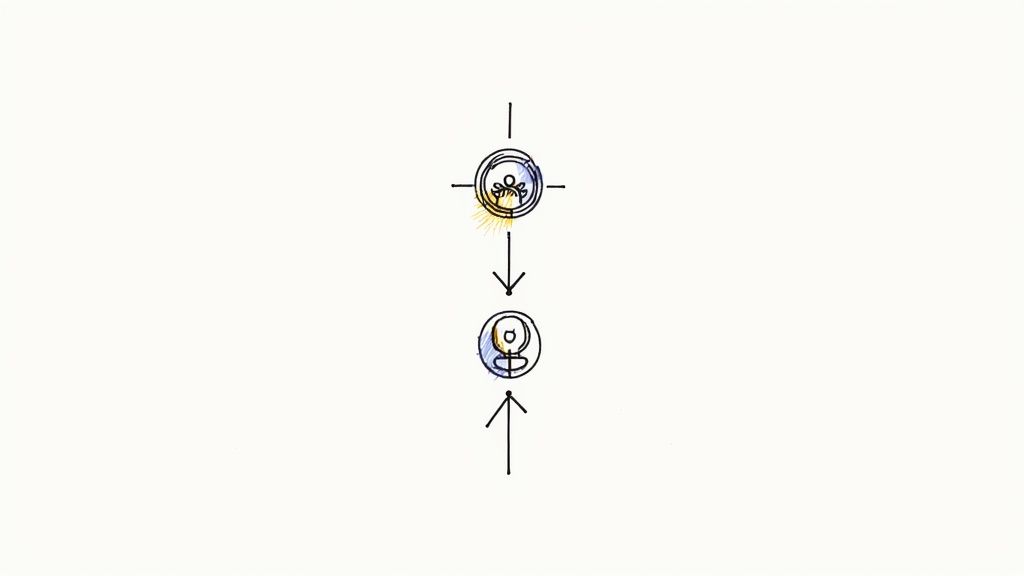
This isn't just about flipping a switch. It's about changing habits, workflows, and mindsets. And if you handle it like a top-down mandate, you're doomed before you start.
Define Your Problem First, Buy the Solution Second
Before you even look at a demo, get your team in a room and ask one simple question: "What is the single biggest bottleneck that’s killing our hiring momentum?"
Is it the soul-crushing time it takes to screen resumes? The endless back-and-forth of scheduling interviews? The fact that good candidates vanish into an inbox black hole?
Get specific. Get honest. Write it on a whiteboard.
The goal of recruitment automation software isn't to automate everything at once. It's to surgically remove the most painful, time-consuming part of your current process. Everything else is just a distraction.
Once you know your #1 enemy, then you can go find the tool designed to defeat it. This approach saves you from being dazzled by a hundred features you’ll never use and ensures you solve a real, tangible problem on day one.
The Phased Rollout: A Founder’s Best Friend
Here’s another classic mistake: trying to go company-wide from the jump. You announce the new platform at an all-hands meeting, force everyone into a two-hour training session, and expect magic to happen. It won't.
Instead, start small. Pick one department—ideally one with a tech-savvy manager and a high hiring volume, like engineering or sales—and make them your pilot group.
This "beta test" approach does a few crucial things:
- It Lowers the Stakes: If something goes wrong (and it will), you're fixing it for a team of 10, not 100. The blast radius is contained.
- It Creates Champions: Once that pilot team starts hiring twice as fast with half the effort, they become your internal evangelists. Their success story will do more to convince skeptics than any corporate memo ever could.
- It Provides a Feedback Loop: You get real, in-the-trenches feedback to work out the kinks before a wider rollout. This is invaluable.
The market for these tools is growing because companies are realizing the immense value of cloud-based, efficient systems. In the United States alone, the recruitment software market was valued at USD 592 million in 2024 and is projected to hit USD 1.36 billion by 2033. For more on this trend, discover more insights about the U.S. recruitment software market from IMARC Group.
Avoiding the Integration Graveyard
The final—and most technical—pitfall is integration. Your new recruitment automation software can't live on an island. It has to talk to your existing systems, like your HRIS, your calendar, and your company's communication tools.
If it doesn't, you haven't removed admin work; you've just created a new, more frustrating kind of it.
Before you sign anything, demand a clear answer on integrations. Does it have a native connection to your existing ATS? Can it sync seamlessly with Google Calendar and Outlook? This is not a "nice-to-have." It is the central nervous system of a successful implementation. A broken integration is a broken process.
For a smooth transition, consider the principles laid out in a comprehensive marketing automation implementation guide, as many lessons are transferable to recruitment automation. A successful rollout isn't about the tech itself; it's about the people and the process you wrap around it.
By defining your problem, starting small, and nailing your integrations, you can avoid the chaos and actually reap the rewards. It's also worth looking into some general recruitment process best practices to ensure your entire strategy is sound from the start.
My Final Take on Choosing the Right Tool
Alright, enough theory. I’ve spent years trying, breaking, and occasionally cursing at dozens of these platforms. This isn’t a gentle summary—it’s the straight-up, unfiltered advice from someone who's seen the good, the bad, and the truly useless in hiring tech.
The core message is painfully simple: recruitment automation software isn't a luxury anymore. It’s a competitive necessity for any company that's actually serious about winning talent, not just posting jobs and praying for a miracle. Sticking with spreadsheets today is like showing up to a Formula 1 race on a tricycle. You're just not in the game.
Choose a Partner, Not Just a Vendor
This is the biggest mistake I see founders make, time and time again. They get wowed by a slick demo and a laundry list of features they’ll never touch, then sign a multi-year contract with a vendor who vanishes the second the payment clears.
Don’t buy a tool. Buy a partner.
Your ideal provider isn't the one with the flashiest interface. It’s the one whose support team understands the gut-wrenching pain of losing a perfect engineering candidate over a simple scheduling screw-up. They need to feel your urgency.
When you're evaluating options, ask them this: "Tell me about a time you helped a client solve a hiring bottleneck that wasn't just a software problem." Their answer will tell you everything you need to know about whether they're a true partner or just another software peddler.
Look for a team that gets it—one that will actually pick up the phone when an integration breaks at 5 PM on a Friday. You’re not just buying a subscription; you’re effectively bringing a new, critical function into your company. Choose wisely.
The bottom line is this: stop trying to patch a fundamentally broken, manual system. The endless email threads, the candidates lost in the shuffle, the wasted hours of your best people—it’s a self-inflicted wound.
It’s time to stop the bleeding. Stop patching, and start building a modern hiring machine that can actually keep up with your ambition. Your future team will thank you for it.
Frequently Asked Questions
Alright, let's tackle some of the questions that always pop up when you're on the verge of ditching the spreadsheets for good. Here are the straight answers you're looking for, no fluff attached.
Will Recruitment Automation Software Replace My Recruiters?
Absolutely not. And any vendor who tells you it will is selling snake oil. The goal of recruitment automation software isn't to replace your people; it's to free them from the robotic, soul-crushing tasks that burn them out.
Think of it as giving your recruiters a hyper-efficient assistant. This assistant handles all the grunt work—the screening, the scheduling, the follow-ups—so your team can finally focus on what they do best: building relationships, assessing cultural fit, and closing top candidates.
Good automation handles the 80% of administrative work so your team can excel at the critical 20% that requires actual human intuition.
Is This Software Only for Large Companies?
This is one of the biggest myths out there. While giant corporations certainly need it, the impact is often even more transformative for startups and small businesses.
Why? Because as a smaller company, you can't afford to have your key people—often the founders themselves—bogged down scheduling interviews and screening resumes. You don't have a massive HR department to absorb the admin load.
The right software levels the playing field. It lets you run a professional, buttoned-up hiring process that competes with the big guys, making you look just as organized and respectful of a candidate's time. It’s about impact and efficiency, not just hiring volume.
How Do I Measure the ROI of This Software?
Don't get distracted by vanity metrics like "time saved." That feels good, but it doesn't tell the whole story. The real ROI shows up in tangible business outcomes.
To prove the value of your recruitment automation software, track these three things religiously:
- Time-to-Fill: How much faster are you closing critical roles? Every day a key position sits empty, you're losing productivity or revenue. This is a hard metric that connects directly to the bottom line.
- Quality of Hire: Are your new hires ramping up faster, performing better, and sticking around longer? Look at performance review data and retention rates 6-12 months after hiring. Better screening should lead to better long-term outcomes.
- Candidate Experience: This one is huge for your employer brand. Use simple, one-question surveys to ask candidates about their experience. A high score means you're building a strong talent pipeline for the future, even with people you don't hire today.
Chasing these metrics forces you to see the software not as a cost center, but as a strategic investment in the single most important part of your business: the people you bring on board.
Ready to stop the administrative grind and start building your team up to 10x faster? Async Interview gives you the tools to automate initial screenings, collaborate effectively, and give every candidate a world-class experience. See how it works and start your free trial at https://asyncinterview.io.


